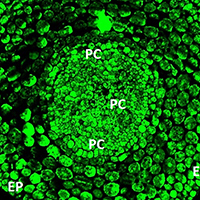Morphological analysis of the seeds of three pseudocereals by using light microscopy and ESEM-EDS

Submitted: 12 October 2019
Accepted: 30 December 2019
Published: 10 January 2020
Accepted: 30 December 2019
Abstract Views: 1256
PDF: 1012
HTML: 60
HTML: 60
Publisher's note
All claims expressed in this article are solely those of the authors and do not necessarily represent those of their affiliated organizations, or those of the publisher, the editors and the reviewers. Any product that may be evaluated in this article or claim that may be made by its manufacturer is not guaranteed or endorsed by the publisher.
All claims expressed in this article are solely those of the authors and do not necessarily represent those of their affiliated organizations, or those of the publisher, the editors and the reviewers. Any product that may be evaluated in this article or claim that may be made by its manufacturer is not guaranteed or endorsed by the publisher.
Similar Articles
- Carlo Alberto Redi, Transgenic mouse - Methods and protocols, 2nd edition , European Journal of Histochemistry: Vol. 55 No. 3 (2011)
- E.P. Carvalho-Filho, A.C. Stabile, E. Ervolino, M.B.S. Stuani, M.M. Iyomasa, M.J.A. Rocha, Celecoxib treatment does not alter recruitment and activation of osteoclasts in the initial phase of experimental tooth movement , European Journal of Histochemistry: Vol. 56 No. 4 (2012)
- W. Theunissen, D. Fanni, S. Nemolato, E. Di Felice, T. Cabras, C. Gerosa, P. Van Eyken, I. Messana, M. Castagnola, G. Faa, Thymosin beta 4 and thymosin beta 10 expression in hepatocellular carcinoma , European Journal of Histochemistry: Vol. 58 No. 1 (2014)
- Manuela Monti, Mistletoe - From mythology to evidence-based medicine , European Journal of Histochemistry: Vol. 59 No. 4 (2015)
- Sabrina Giacoppo, Agnese Gugliandolo, Oriana Trubiani, Federica Pollastro, Gianpaolo Grassi, Placido Bramanti, Emanuela Mazzon, Cannabinoid CB2 receptors are involved in the protection of RAW264.7 macrophages against the oxidative stress: an in vitro study , European Journal of Histochemistry: Vol. 61 No. 1 (2017)
- Tonino Alonzi, Elisa Petruccioli, Valentina Vanini, Gian Maria Fimia, Delia Goletti, Optimization of the autophagy measurement in a human cell line and primary cells by flow cytometry , European Journal of Histochemistry: Vol. 63 No. 2 (2019)
- Simona Zanotti, Francesca Magri, Francesca Poggetti, Michela Ripolone, Daniele Velardo, Francesco Fortunato, Patrizia Ciscato, Maurizio Moggio, Stefania Corti, Giacomo Pietro Comi, Monica Sciacco, Immunofluorescence signal intensity measurements as a semi-quantitative tool to assess sarcoglycan complex expression in muscle biopsy , European Journal of Histochemistry: Vol. 66 No. 3 (2022)
- Mengling Li, Yan Zhao, Jiayi Zhang, Wang Jiang, Siyuan Peng, Jinyue Hu, Yueming Shen, Deubiquitinase USP14 is upregulated in Crohn's disease and inhibits the NOD2 pathway mediated inflammatory response in vitro , European Journal of Histochemistry: Vol. 68 No. 3 (2024)
- M Milanese, L Segat, N Marziliano, S Crovella, The expression of innate immunity genes in Italian Crohn disease patients , European Journal of Histochemistry: Vol. 51 No. 3 (2007)
- E. Coluccia, G. Pichiri, M. Nieddu, P. Coni, S. Manconi, A.M. Deiana, S. Salvadori, R. Mezzanotte, Identification of two new repetitive elements and chromosomal mapping of repetitive DNA sequences in the fish Gymnothorax unicolor (Anguilliformes: Muraenidae) , European Journal of Histochemistry: Vol. 55 No. 2 (2011)
<< < 14 15 16 17 18 19 20 21 22 23 > >>
You may also start an advanced similarity search for this article.

 https://doi.org/10.4081/ejh.2020.3075
https://doi.org/10.4081/ejh.2020.3075










